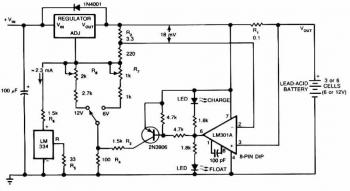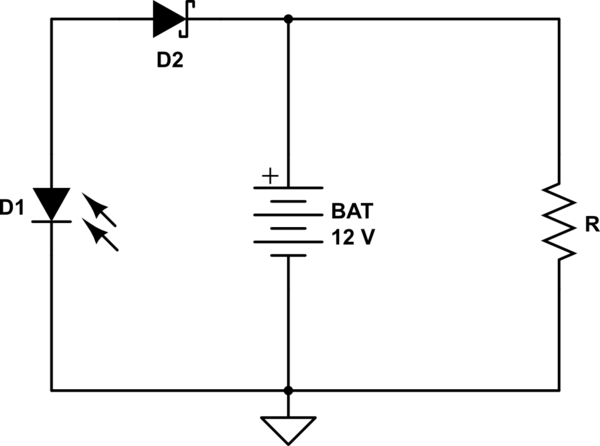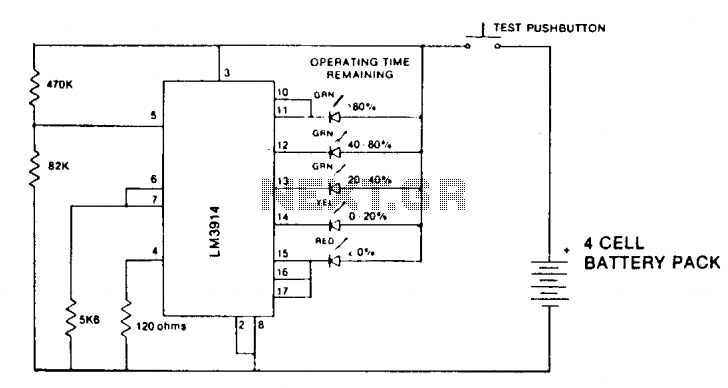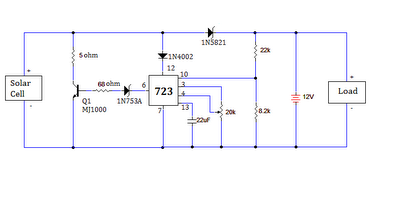
2.5 V Lead-Acid Battery Charger

The following circuit illustrates a 1.5 V Lead-Acid Battery Charger Circuit Diagram. Features include a comparator output that controls the voltage regulator.
The 1.5 V Lead-Acid Battery Charger Circuit is designed to efficiently charge lead-acid batteries while ensuring optimal voltage regulation and protection against overcharging. The circuit utilizes a voltage comparator that monitors the battery voltage and adjusts the output of the voltage regulator accordingly.
In this configuration, the voltage comparator is typically set up with a reference voltage that corresponds to the fully charged state of the battery. When the battery voltage drops below this reference level, the comparator activates the voltage regulator, allowing current to flow into the battery for charging. Conversely, once the battery reaches the desired voltage threshold, the comparator's output will signal the regulator to cease charging, thereby preventing damage to the battery from overvoltage conditions.
Key components in this circuit may include a voltage regulator IC, such as the LM317, which can be adjusted to output the necessary charging voltage. Additionally, protection diodes can be incorporated to safeguard against reverse polarity and to prevent current from flowing back into the circuit when the power source is removed.
The circuit may also include filtering capacitors to stabilize the output voltage and ensure a smooth charging process. A current limiting resistor can be added in series with the output to control the charging current and further protect the battery.
Overall, this simple yet effective circuit design facilitates safe and reliable charging for 1.5 V lead-acid batteries, making it suitable for various applications where such battery technology is employed.The following circuit shows about 1.5 V Lead-Acid Battery Charger Circuit Diagram. Features: comparator s output controls the voltage regulator, .. 🔗 External reference
The 1.5 V Lead-Acid Battery Charger Circuit is designed to efficiently charge lead-acid batteries while ensuring optimal voltage regulation and protection against overcharging. The circuit utilizes a voltage comparator that monitors the battery voltage and adjusts the output of the voltage regulator accordingly.
In this configuration, the voltage comparator is typically set up with a reference voltage that corresponds to the fully charged state of the battery. When the battery voltage drops below this reference level, the comparator activates the voltage regulator, allowing current to flow into the battery for charging. Conversely, once the battery reaches the desired voltage threshold, the comparator's output will signal the regulator to cease charging, thereby preventing damage to the battery from overvoltage conditions.
Key components in this circuit may include a voltage regulator IC, such as the LM317, which can be adjusted to output the necessary charging voltage. Additionally, protection diodes can be incorporated to safeguard against reverse polarity and to prevent current from flowing back into the circuit when the power source is removed.
The circuit may also include filtering capacitors to stabilize the output voltage and ensure a smooth charging process. A current limiting resistor can be added in series with the output to control the charging current and further protect the battery.
Overall, this simple yet effective circuit design facilitates safe and reliable charging for 1.5 V lead-acid batteries, making it suitable for various applications where such battery technology is employed.The following circuit shows about 1.5 V Lead-Acid Battery Charger Circuit Diagram. Features: comparator s output controls the voltage regulator, .. 🔗 External reference





